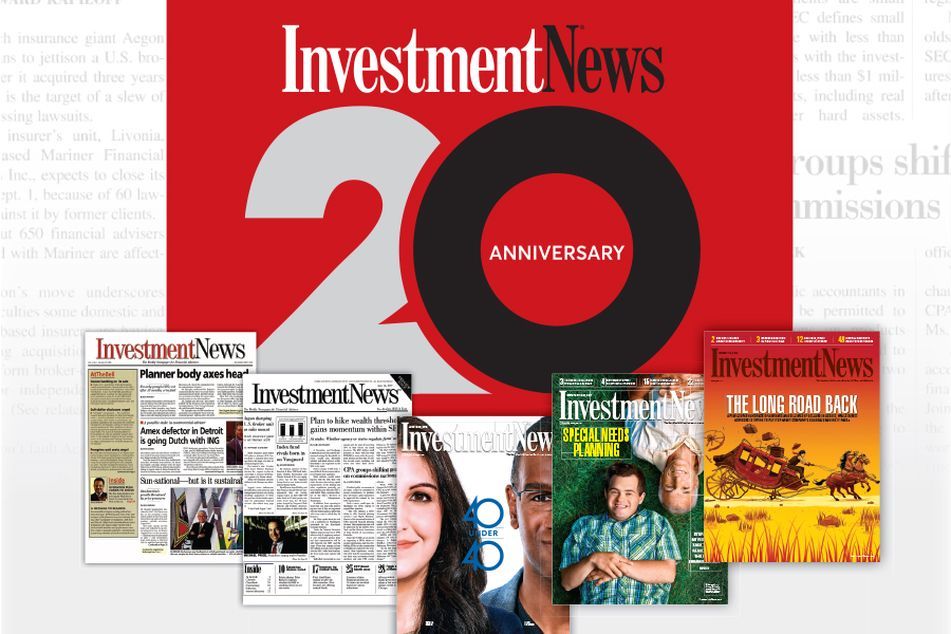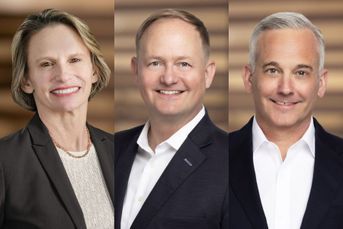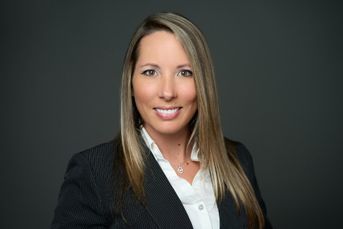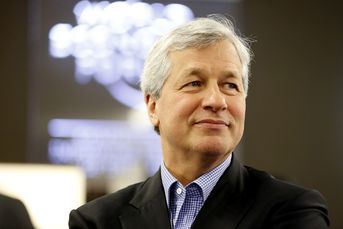InvestmentNews turns 20: A young industry evolves, as does our coverage

A look back at 20 events that rocked financial advisers and their clients, and helped shape our profession.
The 20 years since InvestmentNews launched in 1998 have involved tremendous change in and around the financial advice industry. Here are 20 events that rocked advisers and their clients — many of which will continue to shape the profession as it grows and matures in the years to come.
'Merrill Lynch rule’
The Securities and Exchange Commission proposed the broker-dealer exemption rule in 1999 — exempting fee-based brokerage accounts from fiduciary requirements.
Five years later the Financial Planning Association filed a lawsuit against the agency. The FPA argued the rule would cause confusion among investors about whether they were working with a broker or adviser, who are held to different standards of care. (They also were concerned it would create an unlevel playing field to the detriment of advisers who would be working under a higher standard.)
A U.S. District Court of Appeals ruled in the FPA’s favor in 2007, but the fiduciary war was far from over. A 2008 study confirmed what most in the industry knew: Investors assumed that advisers and brokers who offered the same services were held to the same standard of care.
DOL fiduciary rule
In 2015, then-President Barack H. Obama directed his Labor Department to propose a rule raising investment advice standards for brokers in retirement accounts. Years of research, proposals and comments led to a final fiduciary rule and partial enactment — and many lawsuits. The one the DOL lost was not defended by the Trump administration, and the rule officially died in June.
But the significant changes underway in the industry to meet the rule, and a general understanding that regulators will demand better resolution of conflicts going forward, indicates the core legacy of the DOL fiduciary rule will live on.
SEC advice rule
The Securities and Exchange Commission has gone farther in the last year and a half to reform investment advice standards than it ever has. Under the agency’s proposal, released in April, brokers and advisers continue to be regulated separately — but brokers will be required to act in clients’ “best interest.” Controversy abounds over this undefined term, and the potential confusion it and a new disclosure form could cause for investors, especially those working with dually registered advisers.
It’s hard to guess the future makeup and timing of a final rule, but it’s undoubtedly a priority for chairman Jay Clayton to move this massive regulatory package across the finish line.
Rise of the Roth
The Roth IRA, the brainchild of the late Sen. William V. Roth, has been around for 21 years and has become a mainstay of retirement planning since. Unlike their traditional IRA counterparts, Roth IRA contributions are not tax deductible, but withdrawals at retirement are tax free.
As financial advisers are appreciating more and more the need to balance tax-free sources of income with tax-deferred and Social Security income in retirement to avoid moving into a higher tax bracket, the popularity of these vehicles has grown.
Growth of fee-based revenue and RIAs
By the end of the 1990s, fee-based accounts were entrenched even in the brokerage industry, but they now account for the majority of revenue at many firms. According to a 2017 analysis of leading retail broker-dealers by Aite Group, 66% of revenues stem from fees, versus 34% from commissions. InvestmentNews Research found a similar result looking purely at independent broker-dealers in 2017, with 61% of revenues tied to fees and 39% to commissions.
Registered investment advisers are almost 100% fee-based, according to InvestmentNews Research. Firms in this channel have grown markedly, especially in the last decade. Cerulli Associates reports that RIAs now control 23% of the $20 trillion in adviser-managed assets across the industry.
Tech triggers quantum advance — and robos
Without technology advances over the last 20 years, there would be a much smaller independent advisory industry. From Microsoft Office to the advent of the internet and rise of the cloud, technology has enabled advisers to do their jobs better — and often under their own shingle.
It’s also spawned the robo-adviser movement, with automated advice at a cheap price. The upshot of this development, once thought a threat to human advisers, is turning out to be a huge opportunity: Any adviser can employ a robo tool to serve a broader spectrum of the population efficiently and profitably.
Mutual fund scandal
Coming on the heels of the 2000 technology bubble, the 2001 terror attacks and the stock ratings fraud charges unfolding across the brokerage industry, the 2003 mutual fund industry scandal is sometimes recalled as an afterthought. But the allegations by then-New York attorney general Eliot Spitzer and other regulators that some funds were engaged in illegal late trading and market timing ultimately put some fund firms out of business. Worse, it badly sullied the industry’s squeaky-clean reputation.
Giant money managers
After the financial crash remade the investment landscape and put a renewed focus on fees and the dent they put in long-term returns, famed low-cost mutual fund provider Vanguard Group and ETF behemoth BlackRock stand far above the competition in terms of asset levels. Vanguard has more than $5 trillion in assets under management, while BlackRock surpasses $6 trillion. The next biggest players come in at about half that.
Rise of passive, fall of mutual fund fees
With the growth of passive investing, especially since the long bull market for stocks beginning in 2009, fund families tracking the same benchmarks found the best way to compete was on price. Companies like Vanguard Group began charging an expense ratio of just a few basis points on passive funds, and rivals like Charles Schwab & Co. and Fidelity Investments answered the call. How low can they go? Fidelity introduced the industry’s first free index mutual funds in early August.
And don’t forget the Department of Labor rule in 2012 that required 401(k) plans to, among other things, clearly delineate for participants the fees and expenses of their investment choices. The more transparent costs became, the more discerning retirement savers proved to be.
ETFs grow gangbusters
Global exchange-traded fund assets reached $5.1 trillion in September, according to ETFGI — incredible considering the first U.S. ETF came to life about 25 years ago.
Will they ever overtake the older and more-established mutual fund marketplace, currently at $18.7 trillion? ETFs continue to gain appeal among financial advisers for their low fees, liquidity and tax efficiency, but until they make greater inroads onto retirement plan menus, mutual funds will remain king.
Holistic planning goes mainstream
Considering a client’s whole life in financial planning is standard practice for many advisers today, but it certainly wasn’t 20 years ago. Holistic planning, also called life planning, grew in popularity as baby boomers began to think seriously about what retirement was going to look like. Advisers realized they needed to learn what inspired each client and incorporate that into financial decisions, such as how much to save for children’s college education versus retirement.
Boomer retirement wave hits
The first baby boomers turned 65 in 2011, and according to AARP, 10,000 reach that traditional retirement age every day. The end of 2010 signaled a sea change for the financial services industry that continues today, as firms make the shift from growing clients’ nest eggs to protecting them and building a reliable income stream for the remainder of clients’ lives.
Finra takes the helm
The creation of the Financial Industry Regulatory Authority Inc. in 2007 brought all brokers under the same regulatory roof, achieving a breakthrough for market self-policing. The product of a merger between the National Association of Securities Dealers and the enforcement arm of the New York Stock Exchange, Finra has greater scope and depth than its predecessors.
But critics still question how well a self-regulatory organization can police members it is beholden to.
Social media rules
In little more than a decade, social media has gone from dismissal by the advisory industry to a tool many want to maximize. Seen now as more than just a compliance minefield, some advisers aim to catapult themselves into prospecting machines and industry influencers on social media. But the time commitment for engagement online is separating the wheat from the chaff as far as success in this crowded new world.
Wall Street loses luster
From the subprime-mortgage meltdown to Bernard Madoff’s Ponzi scheme, the numerous examples of self-dealing on Wall Street and beyond over the last couple decades has caused a loss of trust among investors that continues to this day. The larger banks and brokerage houses shouldered much of the blame for the chaos and were on the receiving end of a sizable backlash.
Still, the prevailing sense of pessimism in the retail investor community may have perversely encouraged more people to seek professional advice.
Great Recession rocks investors
It may not have been the most severe economic downturn the United States has ever suffered, but the Great Recession of 2008-09 is the defining experience of the 21st century so far for the investment markets. The S&P 500 fell 38% in 2008. Gross domestic product declined by 0.3% the same year and another 2.8% in 2009, and at one point, unemployment touched 10%. The downturn impacted millions of Americans — not only economically but emotionally.
While the run-up in the stock market over the last 10 years suggests the hangover from the recession has eased, a loss of confidence still prevents some investors from taking advantage of more aggressive options to grow their money.
Central Banks play bigger role
The unprecedented moves by central bankers since the financial crisis have been a blessing and a curse for financial advisers. On one hand, quantitative easing helped propel stock markets to regain all their losses from 2008 — and then some. On the other hand, QE pushed down virtually all sources of income, giving savers fits.
QE ended in 2014, and the Federal Reserve is now raising interest rates — to the chagrin of President Donald J. Trump and the gratitude of older investors looking for a safer investment in which to stash their cash.
Reg D offerings take down some brokerages
Since the financial crisis reached full force in September 2008, when investment banking titan Lehman Brothers Holdings declared bankruptcy, several dozen independent broker-dealers that sold billions in private placements that went bust themselves ended up failing.
Firms could not keep up with the costs of defending themselves against investor arbitrations claims.
“I’ve been in the business for 45 years and nothing has ever come close to the carnage that’s occurred in our industry,” Ron Kovack, co-founder and chairman of independent broker-dealer Kovack Securities Inc., told InvestmentNews in 2010.
Broker protocol
The Protocol for Broker Recruiting emerged in 2004 as a way for the industry to lessen litigation and concerns around privacy of client data when a broker left one firm for another. Protocol firms agreed they would not enforce restrictive covenants, such as nonsolicitation provisions in contracts, as long as the departing adviser took only limited information about clients they personally serviced to their new employer.
But after seeing a steady stream of some of their most productive advisers leave to competitors or start-ups since the credit crisis, Morgan Stanley and UBS Financial Services withdrew from the protocol in the fall of 2017.
The future for the protocol is uncertain. The other two wirehouses, Merrill Lynch and Wells Fargo Advisors, so far have remained in the protocol, but many believe they could change their minds, particularly if Morgan Stanley and UBS see success from the pullout.
Health care uncertainty and innovation
Affording health care, especially as people age after retirement, has become a bigger concern for advisers and their clients as prices for coverage grow each year. Although the U.S. Bureau of Labor Statistics inflation measure for medical care (which includes insurance) has declined in the last couple decades, costs for some services — like long-term care — could break the bank for many elderly people.
Efforts to tackle costs and coverage have had mixed support and success. The Medicare Prescription Drug Act of 2003 also brought about health savings accounts for tax-free spending on care, and the Affordable Care Act of 2010 created federal and state insurance exchanges and a mandate for coverage along with subsidies for lower-income Americans.
No doubt efforts to get a handle on this troublesome issue will continue, though it’s hard to say how great an adjustment to the status quo the U.S. is likely to see anytime soon.
Learn more about reprints and licensing for this article.







